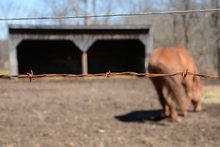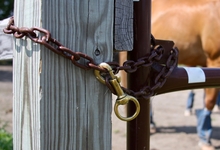-
Select gates large enough for equipment and avoid placing them in low areas.
-
Always consider maintenance costs when buying fencing materials.
-
Make sure your fence is highly visible and has no sharp edges or projections.
-
For good containment, make sure your perimeter fence is at least 5 feet tall.
-
Never rely on appearance only when selecting a fence.
Planning
When planning to fence in your property:
-
Design pasture and paddock space central to the barn, work and feed storage areas.
-
Consider future expansion opportunities.
-
Place gates in the corners of your fence
-
Select gates large enough to get equipment and several horses through at once.
-
Avoid placing gates in low areas where water may pool.
Make sure a sacrifice paddock or dry lot provides at least 400 square feet per horse. These are areas to house your horse when it’s not on pasture.
Budget
When considering fence costs be sure to include both material and maintenance costs. Some fences may cost more up front but have a low maintenance cost. Contrary, some have lower upfront costs and high maintenance cost.
Quoting fence prices can be hard. Table 1 discusses different fences and cost and maintenance estimates.
Safety
For you and your horse’s safety, have your fence properly installed and maintained.
-
Make sure the fence is highly visible.
-
Make sure the fence is solid enough to repel a running horse but flexible enough to prevent injury.
-
Make sure there are no sharp edges or projections anywhere along the fence.
-
Don’t use barbed wire.
-
Avoid square or narrow corners to prevent horses from pinning each other in them.
Installation
You can install the fence yourself or have a professional contractor put it up. Keep in mind improperly installed fences will be less effective with higher maintenance costs. Only install a fence if you have enough expertise.
Containment
The number one function of all fences is containment. Make sure all perimeter fences are about 5 feet high. Dividing fences should be 4.5 to 5 feet high.
Make sure you have an appropriate and secure means to keep your gates closed. A combination of chains, clips or latches are a few common options. Using a combination can better contain your horse in the event that one fails.
Once installed, routinely check your fence for any rails, posts or gates that may need maintenance.
Durability
How long a fence lasts depends on the following:
-
The materials it’s made of.
-
The construction of the fence.
-
The weather exposure it receives.
-
The size and aggressiveness of horses contained.
-
How well you maintain the fence.
-
If you don’t identify and correct problems promptly, even good fences can fall into disrepair.
-
Check manufacturer’s recommendations, independent product test results and other horse owners who currently use the product.
Appearance
Consider the fence’s appearance last. An attractive and well-maintained fence:
-
Promotes pride in ownership.
-
Increases property value.
-
Gives off the impression of professionalism.
You can place more costly, eye appealing fencing in well-traveled areas and less expensive fence in other areas. Keep in mind that all fences must be functional. Don’t rely on appearance alone to select fencing.
Table 1. Common equine fence types, costs, longevity and installation.
| Fence Type | Cost Estimate | Maintenance Estimate | Expected Life (yrs) | Installation Labor Required |
|---|---|---|---|---|
| Wood (post and rail) | High | High | 15-20 | High |
| Plastic (post and rail) | High | Moderate | 20-30 | High |
| Steel Pipe | High | Low | 15-20 | High |
| High Tension Wire | Moderate | Moderate | 20 | Moderate |
| Electric Wire | Low | Low | 20-25 | Low |
| Electric Tape | Low | Low | 10 | Low |
Reviewed in 2021




